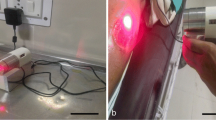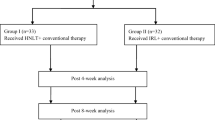Abstract
To compare the influence of laser and LED on tissue repair and neuropathic symptoms during treatment of diabetic foot. An intervention survey conducted in a health center located in Brazil, contemplating ten sessions, twice a week, with randomization in two groups. In one group, the wounds were treated with GaAlAs laser, with a wavelength of 830 nm, 30 mW, and power density 0.84 W/cm2, the other group by LED 850 nm, 48 mW, and power density 1.05 W/cm2. For the analysis of wound size, photographic records analyzed by the ImageJ® software were used, and the neuropathy evaluation card examined. With regard to the laser group, a reduction in wound extension of 79.43% was observed at the end of the 10th session; the patients in the LED group had a 55.84% decrease in the healing process; comparing the two therapies was observed a better healing in the participants of the laser group, with 81.17%, in relation to the LED after the end of the sessions; regarding the evaluation of the neuropathic condition, there was a significant improvement in both therapies. There was improvement of the neuropathic signs and symptoms, also improvement of the tissue repair in the two therapeutic modalities; however, the laser presented a higher rate of speed in relation to the LED.


Similar content being viewed by others
References
2017) Promoting Health and Reducing Disparities in Populations [editorial]. Journal of clinical and applied research and education diabetes care 40 (suppl 1): 6–10. doi:https://doi.org/10.2337/dc17-S004
Ministry of Health (BR) (2016) Diabetic foot manual: a strategy for the care of the person with chronic disease. Ministry of Health, Brasília
(2017) Evaluation and treatment of patients with neuropathy: pain and autonomic neuropathy [editorial]. Guidelines of the Brazilian Society of Diabetes. São Paulo: Clannad. p. 291–299
Sousa RG, Batista KNM. Laser therapy in wound healing associated with diabetes mellitus- review. In: Anais Brasileiros de Dermatologia, Rio de Janeiro. Rio de Janeiro: Brazilian Society of Dermatology 2016; 91 (4): 489–493. doi: https://doi.org/10.1590/abd1806-4841.20163778
Tatmatsu Rocha JC, Ferraresi C, Hamblin MR, Damascene FM, Birth NRF, Driusso P et al (2016) Low-level laser therapy (904 nm) can increase collagen and reduce oxidative and nitrosative stress in diabetic wounded mouse skin. J Photochem Photobiol 164:96–102. https://doi.org/10.1016/j.jphotobiol.2016.09.017
Steiger S; Veprek RG.; Witzigmann B Unified modelling of electro luminescence in nano structures. 9th International Conference on Numerical Simulation of Opto Electronic Devices. September/2009; p.73–74. doi:10.1109/NUSOD.2009.5297218
Moreno I, Sun C-C (2008) Modeling the radiation pattern of LEDs. Opt Express 16(3):1808–1819. https://doi.org/10.1364/oe.16.001808
Heiskanen V, Hamblin MR (2018) Photobiomodulation: lasers vs. light emittingdiodes? Photochem Photobiol Sci 17(8):1003–1017. https://doi.org/10.1039/c8pp00176f
Schubert EF (2018) Light-emitting diodes. E. Fred Schubert
Muehlemann T, Haensse D, Wolf M (2008) Wireless miniaturized in-vivo near infrared imaging. Opticsexpress 16(14):10323–10330. https://doi.org/10.1364/OE.16.010323
Shashi KCG, Maya AG, Hande HM, Vidyasagar S, Rao K, Rajagopal KV (2015) Efficacy of low level laser therapy on painful diabetic peripheral neuropathy. Laser Ther 24(3):195–200. https://doi.org/10.5978/islsm.15-OR-12
Brazil. Ministry of Health. Resolution no. 466, of December 12, 2012. Guidelines and Norms Regulating Research involving human beings. Official Gazette of the Federative Republic of Brazil. 2012 dez. 12; Section 1. P. 5
Haslbeck M, Luft D, Neundorfer B, Stracke H, Ziegler D (2004) Diagnosis, treatment and follow-up of diabetic neuropathy. 2. ed. German Diabetes Association, Germany
Moreira RO, Castro AP, Papelbaum M, Appolinário JC, Ellinger VC, Coutinho WF et al (2005) Translation into Portuguese and assessment of the reliability of a scale for the diagnosis of diabetic distal polyneuropathy. Arq Bras Endocrinol Metab 49(6):944–950 Portuguese
Silveira PC et al (2016) Effect of low-power laser (LPL) and light-emitting diode (LED) on inflammatory response in burn wound healing. Inflammation 39(4):1395–1404. https://doi.org/10.1007/s10753-016-0371x
Tatmatsu-Rocha JC, Tim CR, Avo L, Bernardes Filho R, Brassolati P, Kido HW, Parizotto NA (2018) Mitochondrial dynamics (fission and fusion) and collagen production in a rat model of diabetic wound healing treated by photobiomodulation: comparison of 904 nm laser and 850 nm light-emitting diode (LED). J Photochem Photobiol B Biol 187:41–47. https://doi.org/10.1016/j.jphotobiol.2018.07.032
Carvalho AFM, Feitosa MCP, Rabbit NPMF, Vet VCN, Castro JG, Sousa PRG et al (2016) Low-level laser therapy and calendula officinalis in repairing diabetic foot ulcers. Revista da Escola de Enfermagem da USP 50(4):628–634. https://doi.org/10.1590/S0080-623420160000500013
Epidemiology and Prevention [editorial]. Guidelines of the Brazilian Society of Diabetes. Rio de Janeiro: AC Pharmaceuticals; 2016. P. 3–6
Armstrong DG, Boulton AJM, Bus AS (2017) Diabetic foot ulcers and their recurrence. N Engl J Med 376:23672375. https://doi.org/10.1056/NEJMra1615439
Tatmatsu Rocha JC, de Castro CA, Sene-Fiorese M, Parizotto NA (2017) Light-emitting diode modulates carbohydrate metabolism by pancreatic duct regeneration. Lasers Med Sci 32(8):1747–1755. https://doi.org/10.1007/s10103-017-2245-3
Beckmann KH, Hamme GM, Schroder S (2014) Low level laser therapy for the treatment of diabetic foot ulcers: a critical survey. Evid Based Complement Alternat Med 2014:95–102. https://doi.org/10.1155/2014/626127
Moura RO, Nunes LCC, Carvalho MEIM, Miranda BR (2014) Effects of light emitted by diodes (LED) and chitosan compounds on wound healing systematic review. J Appl Basic Pharmaceut Sci 35(4):513–518
Agnol MAD, Nicolau A, Lima CJ, Munin E Comparative analysis of coherent light action (laser) versus non-coherent light (light-emitting diode) for tissue repair in diabetic rats. Laser Med Sci 200(2):909–916. https://doi.org/10.1007/s10103-009-0648-5
Chaves MEA, Araújo AR, Piancastelli ACC, Pinotti M (2014) Effects of low power light therapy on wound healing: LASER x LED. In: Anais Brasileiros de Dermatologia, Rio de Janeiro. Rio de Janeiro: Brazilian Society of Dermatology. 89 (4): 616–623. https://doi.org/10.1590/abd1806-4841.20142519
Karu TI, Kolyakov SF (2005) Exact action spectra for cellular responses relevant to phototherapy. Photomed Laser Surg 23(4):355–361. https://doi.org/10.1089/pho.2005.23.355
Ferraresi C, Dos Santos RV, Marques G, Zangrande M, Leonaldo R, Hamblin MR et al (2015) Light-emitting diode therapy (LEDT) before matches prevents increase in creatine kinase with a light dose response in volleyball players. Lasers Med Sci 30(4):1281–1287. https://doi.org/10.1007/s10103-015-1728-3
Nishioka MA, Pinfildi CE, Sheliga TR, Arias VE, Gomes HC, Ferreira LM (2012) LED (660 nm) and laser (670 nm) use on skin flap viability: angiogenesis and mast cells on transition line. Lasers Med Sci 27:1045–1050. https://doi.org/10.1007/s10103-011-1042-7
Corazza AV, Jorge J, Kurachi C, Bagnato VS (2017) Photobiomodulation on the angiogenesis of skin wounds in rats using different light sources. Photomed Laser Surg 25(2):102–106. https://doi.org/10.1089/pho.2006.2011
Sousa APC, Paraguassú GM, Silveira NTT, Souza J, Cangussú MCT, Santos JN, Pinheiro ALB (2013) Laser and LED phototherapies on angiogenesis. Lasers Med Sci 28:981–987. https://doi.org/10.1007/s10103-012-1187-z
Author information
Authors and Affiliations
Corresponding author
Ethics declarations
Ethical approval
All procedures performed in this study, involving human participants, were in accordance with the ethical standards of the Ethics and Research Committee on Human Studies of the Federal University of Ceará (number 1.817.533).
Conflict of interest
The authors declare that they have no conflict of interest.
Additional information
Publisher’s note
Springer Nature remains neutral with regard to jurisdictional claims in published maps and institutional affiliations.
Rights and permissions
About this article
Cite this article
Vitoriano, N.A.M., Mont’Alverne, D.G.B., Martins, M.I.S. et al. Comparative study on laser and LED influence on tissue repair and improvement of neuropathic symptoms during the treatment of diabetic ulcers. Lasers Med Sci 34, 1365–1371 (2019). https://doi.org/10.1007/s10103-019-02724-5
Received:
Accepted:
Published:
Issue Date:
DOI: https://doi.org/10.1007/s10103-019-02724-5




